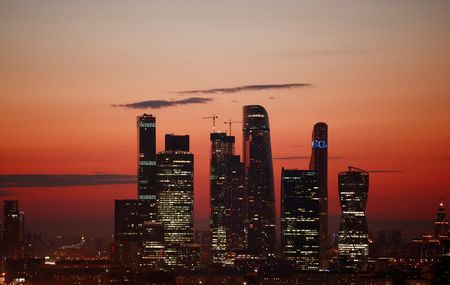By Darya Korsunskaya and Alexander Marrow
MOSCOW (Reuters) -Russia’s economy ministry revised higher on Friday its 2023 gross domestic product (GDP) forecast to 1.2% growth from a 0.8% contraction, but lowered its forecast for 2024, mirroring a wider trend that envisages more sluggish longer term prospects.
The International Monetary Fund this week also raised its forecast for Russia’s 2023 economic growth, but said the country may see a sharply wider budget deficit and a smaller current account surplus this year. It said Russia’s global isolation and lower energy revenues could harm its growth potential for years.
The economy ministry forecast GDP growth of 2% in 2024, down from 2.6% when it last provided macroeconomic forecasts in the autumn.
Russia’s economy defied early expectations for a double-digit economic contraction in 2022, in forecasts made soon after Moscow sent troops into Ukraine in February of that year, but a return to prosperity remains a long way off as the government directs more spending towards the military.
The Russian economy shrank 2.1% in 2022. Before Moscow began what it calls a “special military operation” in Ukraine, the government had expected 3% growth.
The ministry, focused on bringing about a recovery in consumer demand, raised its forecasts for retail sales, real wages and real disposable incomes in 2023, but lowered them slightly for 2024. Unemployment is set to remain at a record low of 3.5% through 2026, the ministry estimates.
“Demand will recover both as the population’s propensity to save is normalised and as consumer lending grows,” Economy Minister Maxim Reshetnikov said.
SHRINKING SURPLUS
Russia’s current account surplus is shrinking sharply, down around 73% in the first quarter of 2023. Robust oil and gas exports had combined with collapsing imports to push the surplus to a record high in 2022.
The ministry almost halved its forecast for the current account surplus in 2023 to $86.6 billion from $157.6 billion previously and slashed its trade balance forecast by around a third to $152.1 billion.
Economists from the Institute of International Finance said Russia had a large “excess” current account surplus in 2022, with a surplus above and beyond the normal seasonal path in 2021 and 2022.
“This amounts to a windfall of roughly 13% of GDP, which contributed to flush liquidity in Russia’s financial system that – in turn – buffered growth,” the IIF said in a report published on Thursday.
“This windfall has ended in 2023, with Russia’s current account surplus below ‘normal’, likely one reason why the rouble has weakened year-to-date,” it added.
The rouble is down around 10% year-to-date, the third-worst performer among global currencies so far this year, struggling under the weight of a Western oil price cap and shrinking export revenues.
The economy ministry lowered its rouble rate forecast to 76.5 to the dollar in 2023, from 68.3 in the previous forecast, and to 76.8 from 70.9 in 2024.
BRENT SWITCH
The ministry provided estimates of the Brent oil price, rather than Russian Urals as usual, envisaging an oil price of $80.7 per barrel this year and $75.7 per barrel in 2024.
Interfax news agency quoted a source as saying that the switch was because Urals was now “unrepresentative”. Western sanctions have forced Russia to sell oil at a discount, skewing the Urals price.
The ministry did not provide production and export estimates for oil, oil products and gas. A source told Reuters this was an effort to counteract sanctions.
(Reporting by Reuters, Darya Korsunskaya and Alexander MarrowEditing by Gareth Jones and Barbara Lewis)





